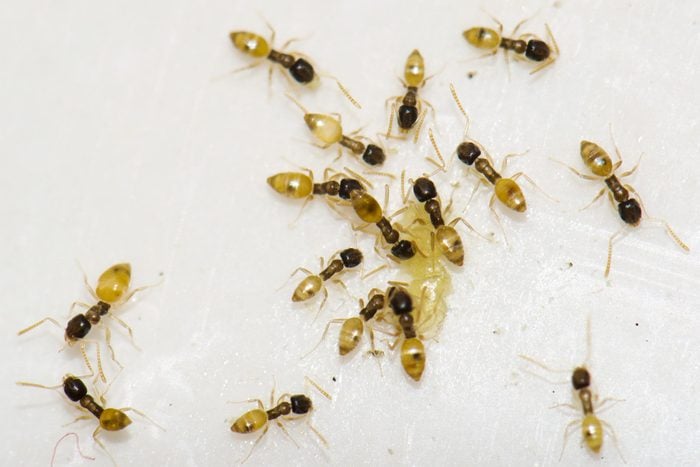A Homeowner’s Guide to Ghost Ants
Updated: Mar. 29, 2023

Tiny ghost ants are almost invisible, and they're especially attracted to sweets in the kitchen. Once they find something, you've got a big problem.
You might expect the ghost ant to be scarier than it is. The creepy name actually derives from its light color, which makes it difficult to see.
These ants like it warm. They favor Southerly climates, although they manage to find their way into warm indoor environments in colder places. Colonies have been discovered in apartment buildings and greenhouses as far north as Winnipeg, Manitoba.
If you live in a climate where ghost ants can survive outdoors, you’re likely to find them swarming around the undersides of leaves. That’s where aphids and other insects leave deposits of honeydew, which ghost ants love. Like other ant species that relish the sweet, sticky stuff, ghost ants protect the producers from other predators, a symbiotic relationship that ensures a steady food source.
On This Page
What Are Ghost Ants?
Ghost ants, also known as black-headed ants, are tiny, less than one-sixteenth of an inch. The head and thorax are dark brown, while the gaster (the bulbous hind part of the body) and legs are an almost translucent milky white.
When viewed on a light surface, the legs and gaster all but disappear, giving the impression of a disembodied head. On a dark surface, the head also disappears.
In North America, the ghost ant is well established in Florida and Hawaii while expanding to areas like southern Texas. In those places, outdoor colonies can be found under objects on the ground, under loose bark, in clumps of damp grass and even in flower pots. Colonies produce multiple sub-colonies, each with its own queen.
In Northern climates where ghost ants can’t survive outdoors, they frequently nest dark, protected and warm places — inside walls, and between cabinetry and baseboards.
What Do Ghost Ants Eat?
Besides honeydew, ghost ants will feast on any sweet stuff they find on the kitchen floor. They also like protein, feeding on living and dead insects — a diet perhaps more in tune with their name.
Signs of a Ghost Ant Infestation
By itself, a ghost ant may be hard to see, but collectively they’re far more visible. When you have an infestation, it will be obvious. The ants will form trails in your kitchen or anywhere else they can find sweets. If you crush one (or several), you’ll smell something resembling rotten coconuts.
Are Ghost Ants Harmful?
Yes, because they can contaminate food. If you see ghost ants swarming around a bowl of pudding you left on the table, throw it out, because you don’t know where they’ve been. They could have emerged from under the toilet or walked over a pile of mouse droppings behind the wall.
Ghost ants don’t have stingers. They can bite if they feel threatened, but it isn’t painful and you probably won’t notice it.
How To Get Rid of Ghost Ants
Ghost ants can be particularly difficult to eradicate. Even if you keep your house clean and dry, these tiny scavengers can find nourishment even when you don’t think there’s any around.
Store-bought baits containing boric acid in a syrupy solution, like Terro, can help eliminate a colony. The worker ants take the bait back to the nest and feed the queen. But because these ants form several colonies, this may be a temporary solution.
For more immediate relief, spray the ant trail with an oil-based pest control product like Orange Guard. It kills on contact, keeps ants away, and it’s safe to use around food.
If a trail leads to a particular opening in the wall or baseboard, try drilling a small hole and dusting behind the wall with boric acid or diatomaceous earth. You can also simply suck up the ants with a vacuum cleaner with a crevice tool.
How To Keep Ghost Ants Away
Several safe, non-toxic products keep ghost ants from coming back. Make a spray by mixing one of the following with water:
- Peppermint oil;
- Vinegar;
- Lemon juice;
- Cinnamon;
- Cayenne or black pepper.
Spray frequently around areas where you’ve seen active trails.
It’s also important to trim vegetation around the outside of the house, because ghost ants may be nesting there. Check indoor plants as well. Seal gaps between baseboards and the walls and floor with caulk.
If all else fails, you may need to call a pro licensed to use pest control chemicals that aren’t available to homeowners.
